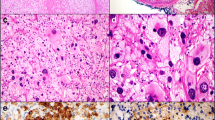Abstract
Adrenal incidentalomas detected during pregnancy are very rare, and the natural history of these tumors during gestation is unknown. We report a case of a pregnant woman with an adrenal mass discovered serendipitously, who was followed-up during gestation and underwent adrenalectomy shortly after delivery. This allowed the evaluation of both the clinical outcome and the molecular/immunohistochemical correlates. Estrogens may indeed influence the function and proliferation of human adrenal cells, and a state of circulating estrogen excess can represent an in vivo model to test their effect on the adrenals. No evidence of adrenal change in morphology and function was found in our patient throughout pregnancy, as shown by adrenal ultrasound imaging and adrenal hormone measurements. Four months after delivery, the patient underwent laparoscopic right adrenalectomy, and pathologic analysis revealed a 2.7 cm benign adrenocortical adenoma. The diameter of the adrenal mass at ultrasonography correlated highly with post-partum mass diameter measured by abdominal computed tomography (CT). Quantitative expression of both ERα and ERβ by real-time RT-PCR analysis and Western blotting findings did not differ among adenoma, normal adjacent adrenal and normal adrenal control tissues. This case of an adrenal incidentaloma discovered during pregnancy shows that a close observation with endocrine investigations and ultrasonography could be an appropriate approach, delaying the decision of surgical intervention after delivery. Estrogen receptor mRNA levels in the adrenal mass similar to those observed in normal adrenals suggest that estrogen oversecretion during pregnancy was not a risk factor for tumor progression.
Similar content being viewed by others
References
Mastorakos G, Ilias I. Maternal and fetal hypothalamic-pituitary-adrenal axes during pregnancy and postpartum. Ann N Y Acad Sci 2003, 997: 136–49.
Okawa T, Asano K, Hashimoto T, et al. Diagnosis and management of primary aldosteronism in pregnancy: case report and review of the literature. Am J Perinatol 2002, 1 9: 31–6.
Mannelli M, Bemporad D. Diagnosis and management of pheochromocytoma during pregnancy. J Endocrinol Invest 2002, 25: 567–71.
Polli N, Pecori Giraldi F, Cavagnini F. Cushing’s syndrome and pregnancy. J Endocrinol Invest 2003, 26: 1045–50.
Chandraharan E, Arulkumaran S. Pituitary and adrenal disorders complicating pregnancy. Curr Opin Obstet Gynecol 2003, 15: 101–6.
Harrington JL, Farley DR, van Heerden JA, Ramin KD. Adrenal tumors and pregnancy. World J Surg 1999, 23: 182–6.
Fischler L, Ensner R, Bernhardt D. Preoperatively asymptomatic left adrenal incidentaloma. Schweiz Med Wochenschr 1999, 29: 1033–8.
Barzon L, Sonino N, Fallo F, Palù G, Boscaro M. Prevalence and natural history of adrenal incidentalomas. Eur J Endocrinol 2003, 149: 273–85.
Takeyama J, Suzuki T, Inoue S, et al. Expression and cellular localization of estrogen receptors alpha and beta in the human fetus. J Clin Endocrinol Metab 2001, 86: 2258–62.
Somjen D, Stern D, Knoll E, et al. Carboxy derivatives of isoflavones as affinity carriers for cytotoxic targeting in adrenocortical H295R carcinoma cells. J Endocrinol 2003, 179: 395–403.
Hsing AW, Nam JM, Co Chien HT, McLaughlin JK, Fraumeni JF Jr. Risk factors for adrenal cancer: an exploratory study. Int J Cancer 1996, 65: 432–6.
Neville AM, O’Hare MJ. Histopathology of the human adrenal cortex. Clin Endocrinol Metab 1985, 14: 791–820.
McNicol AM, Laidler P. The adrenal gland and extra-adrenal paraganglia. In: Lewis PD ed. The Endocrine System. London: Churchill Livingstone. 1996, 12: 59–129.
Latil A, Bieche I, Vidaud D, et al. Evaluation of androgen, estrogen (ER alpha and ER beta) and progesterone receptor expression in human prostate cancer by real-time quantitative transcription-polymerase chain reaction assays. Cancer Res 2001, 61: 1919–26.
Hsu S-M, Raine L, Fanger H. Use of avidin-biotin-peroxidase complex (ABC) in immunoperoxidase techniques: A comparison between ABC and unlabeled antibody (PAP) procedures. J Histochem Cytochem 1981, 29: 577–80.
Miller K, Auld J, Jessup E, Rhodes A, Ashton-Key M. Antigen unmasking in formalin-fixed routinely processed paraffin wax-embedded sections by pressure cooking: a comparison with microwave oven heating and traditional methods. Adv Anatomic Pathol 1995, 2: 60–4.
Grumbach MM, Biller BMK, Braunstein GD, et al. Management of the clinically inapparent adrenal mass (“incidentaloma”). Ann Intern Med 2003, 138: 424–9.
Mansmann GG, Lau J, Balk E, et al. The clinically inapparent adrenal mass: update in diagnosis and management. Endocr Rev 2004, 25: 309–40.
Abrams HL, Siegelman SS, Adams DF, et al. Computed tomography versus ultrasound of the adrenal gland: a prospective study. Radiology 1992, 143: 121–8.
Fontana D, Porpiglia F, Destefanis P, et al. What is the role of ultrasonography in the follow-up of adrenal incidentalomas? The Gruppo Piemontese Incidentalomi Surrenalici. Urology 1999, 54: 612–6.
Nillsson S, Makela S, Treuter E, et al. Mechanisms of estrogen action. Physiol Rev 2001, 81: 1535–65.
Hirst JJ, West NB, Brenner RM, Novy MY. Steroid hormone receptors in the adrenal glands of fetal and adult rhesus monkeys. J Clin Endocrinol Metab 1992, 75: 308–14.
Albrecht ED, Babischkin JS, Davies WA, Leavitt MG, Pepe GJ. Identification and developmental expression of the estrogen receptor alpha and beta in the baboon fetal adrenal gland. Endocrinology 1999, 140: 5953–61.
Enmark E, Pelto-Huikko M, Grandien K, et al. Human estrogen receptor β-gene structure, chromosomal localization, and expression pattern. J Clin Endocrinol Metab 1997, 82: 4258–65.
Nakao M, Sato B. Koga M, et al. Biochemical and immunological characterization of estrogen binding components in human neoplastic adrenocortical tissues. J Steroid Biochem 1986, 25: 1–9.
Sanfilippo JS, Wittliff JL. Steroid hormone receptors in adrenal cortical carcinoma. Am J Obstetr Gynecol 1984, 150: 326–7.
Fassnacht M, Kenn W, Allolio B. Adrenal tumors: how to establish malignancy? J Endocrinol Invest 2004, 27: 387–99.
Author information
Authors and Affiliations
Corresponding author
Rights and permissions
About this article
Cite this article
Fallo, F., Pezzi, V., Sonino, N. et al. Adrenal incidentaloma in pregnancy: Clinical, molecular and immunohistochemical findings. J Endocrinol Invest 28, 459–463 (2005). https://doi.org/10.1007/BF03347228
Accepted:
Published:
Issue Date:
DOI: https://doi.org/10.1007/BF03347228




